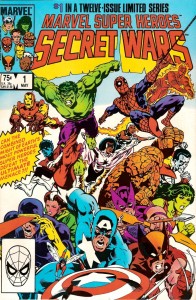 So we continue to work our way backwards from Spider-Man beating up Firelord, former herald of Galactus, to Spider-Man teaching the cosmic, godlike Beyonder how to go poop, to the miniseries which started this whole chain of events, the year-long mega-event, Marvel Super Heroes Secret Wars.
So we continue to work our way backwards from Spider-Man beating up Firelord, former herald of Galactus, to Spider-Man teaching the cosmic, godlike Beyonder how to go poop, to the miniseries which started this whole chain of events, the year-long mega-event, Marvel Super Heroes Secret Wars.
It all started in December of 1983 (cover dated April, 1984), when in the final panels of their various books, a number of the Marvel Universe’s greatest heroes–the Avengers, Fantastic Four, Spider-Man–either mysteriously disappeared or else decided to enter a strange alien structure which had appeared in Central Park, which itself disappeared after they entered.
In January 1984 (cover dated May), the heroes returned, but with big changes. She-Hulk was no longer an Avenger, but now a member of the Fantastic Four, replacing the Thing, who did not return. Magneto, long the X-Men’s greatest arch-nemesis, was now a sort-of member of the group. And Spider-Man had a mysterious new black costume.
At the same time, a new series, Marvel Super Heroes Secret Wars, published its first issue, which would tell the entire story in twelve issues over the full year. Scripted by Marvel editor-in-chief Jim Shooter and drawn by Mike Zeck and John Beatty (with one fill-in issue by Bob Layton, and some various uncredited art assists), the series opened with the heroes appearing inside a mysterious alien structure in outer space. And even though they pretty much all know each other, the first thing they do is introduce themselves.
If you plan to read Secret Wars, get used to that level of clunky, rote exposition, because you’re going to read a lot of it. Every issue is going to have a bunch of obligatory recap that becomes sheer torture to read by the last few issues.
Not only are there 19 heroes, but another structure appears nearby, full of villains, from the world-eating Galactus (!) and Doctor Doom, all the way down to losers like the Wrecker and the other three members of his Wrecking Crew (who?). And then there’s Magneto, ostensibly a villain, but he winds up in the heroes’ lounge for some reason.
Suddenly a rift in space appears, and a disembodied, godlike voice starts out by saying, “I am from Beyond.”
This was, of course, the first appearance of the Beyonder, who would quickly descend from omnipotent cosmic force to incredibly boring buffoon by the midpoint of Secret Wars II. Then, just to show off, the Beyonder destroys a galaxy for our heroes’ amusement, after which he assembles a planet from pieces of hundreds of other worlds, and orders the two sides to fight it out.
Galactus decides he doesn’t want to play and goes after the Beyonder himself, pursued by Doctor Doom. But Galactus is casually tossed away, and Doom as well, which is how we discover that Galactus may be ultra-powerful, but even he sometimes puts his shoes on the wrong feet. Or maybe his feet are just backwards.
Anyway, there’s a lot of fighting. Both the heroes and the villains bicker amongst themselves, split apart and recombine in various configurations. Eventually, Galactus tries to eat the planet, so the heroes try to stop him and fail. But Doctor Doom manages to figure out a way to steal Galactus’s power, and uses that plus his incredible intellect to figure out a way to steal the Beyonder’s power.
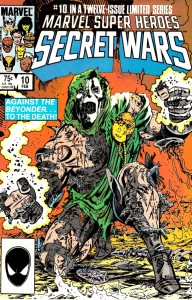 At which point Doctor Doom has basically become God and decided he is above fighting the heroes any more. In Shooter’s characterization, he was basically always fighting them just to prove his superiority, and now he really has nothing left to prove.
At which point Doctor Doom has basically become God and decided he is above fighting the heroes any more. In Shooter’s characterization, he was basically always fighting them just to prove his superiority, and now he really has nothing left to prove.
A word about Shooter’s characterization: as you might expect, even with 12 issues to play with, a book featuring a cast of 20 heroes and a like number of villains does not allow much room for any sort of in-depth or subtle characterization. Shooter tries to give everybody their moment in the spotlight, but some folks inevitably get short shrift, like Nightcrawler and Rogue from the X-Men, or the Wrecking Crew (seriously, who?).
What he has to do for the most part is resort to “funny hat” characterization, giving everybody one basic characteristic that is a consistent part of their character. So Hulk is belligerent, the Human Torch is cocky, Colossus is lovestruck, Wasp is a spoiled rich girl (at one point, she seriously gets upset after crashing in the middle of nowhere in a stolen hovercraft because she broke a nail). And for an action-packed story for adolescent boys, there’s a ton of mooning over girls, and even a little romance, like this interlude between Magneto and Wasp, which gives you an idea of how much Shooter has to compress his dialogue to cram everything in.
At the same time, in order to make the series the Coolest! Thing! Ever!, Shooter feels the need to shovel endless amounts of hype over everything. So when the Beyonder demonstrates his power, he destroys a galaxy! Molecule Man drops an entire mountain range (that we’re told dwarfs the Andes) on our heroes! Which Hulk catches and holds up to keep everyone from being crushed! Then Reed Richards (super-brain) builds an ultra-super-blaster from Iron Man’s repulsors, Hawkeye’s arrows and Spider-Man’s webshooters, in minutes, with his bare hands, despite having never seen what components any of these devices contain.
Even in the non-action scenes, Shooter feels the need to pump things up. Alien machines are unimaginably complex, made of alloys that are super-hard, in rooms that are incredibly big. The problem is that the hype is empty, never really earned.
And by the end, the characters become so extremely one-note that it becomes almost unbearable to keep reading. Doctor Doom is supposed to be super-smart and super-ambitious, so he steals the power of God himself. But Captain America, who believes in Justice and Never Quits, decides to fight Doctor Doom. Because in Jim Shooter’s moral universe, Lawful Good Does Indeed Mean Lawful Stupid, so Captain America decides to throw his shield at God. And because Good must triumph over Evil, it works.
About the only character to escape this awful fate was Spider-Man, who gets the requisite funny hat characteristics of wisecracks and an inferiority complex. But he is refreshingly human, and he gets not one, but two moments of cool, neither of which is too over-the-top. First, he manages to run rings around the entire team of X-Men, and then, in issue #8, he stands toe-to-toe against the super-strong Titania, who has struck fear into the hearts of the other heroes with her incredible strength and invulnerability.
But in the end, although the series was in parts a fun read, its good was mostly overwhelmed by the boring and the stupid parts. Even worse, it gave birth to the wretchedly awful Secret Wars II, which we unfortunately cannot wish out of existence, but can mostly ignore. Within a year or two, all of the supposed world-shaking changes had been undone–the Thing had returned to Earth, Magneto had become a bad guy again, Spider-Man had dumped his alien black costume. The most enduring legacy of the entire series was the fact that writer David Michelinie and artist Todd McFarlane later resurrected the abandoned black costume years later to create the fan-favorite villain Venom, long after Secret Wars was a distant memory.
Well, that and the fact that huge multi-character crossover event miniseries are now Standard Operating Procedure at both Marvel and DC. And Marvel continues to try to milk that original cash cow, as well, through reprints of the series. The latest gimmick has been to reprint every issue of the original miniseries, packaged with two action figures for around $15 each. That would cost you around$180 to read the entire series from beginning to end.
Trust me, it is so not worth that much.

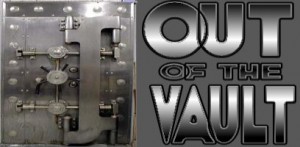
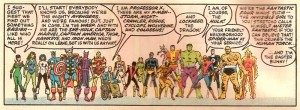
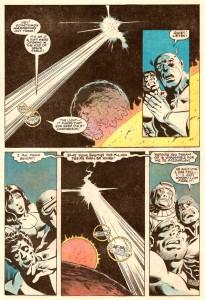
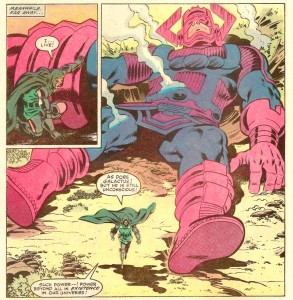
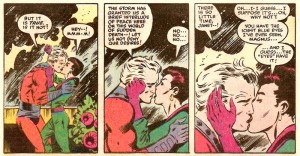
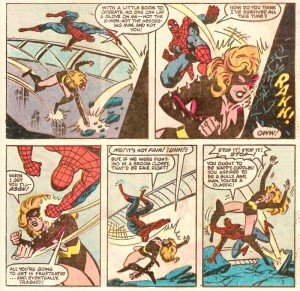



Pingback: Out of the Vault – Contest of Champions | Hero Go Home